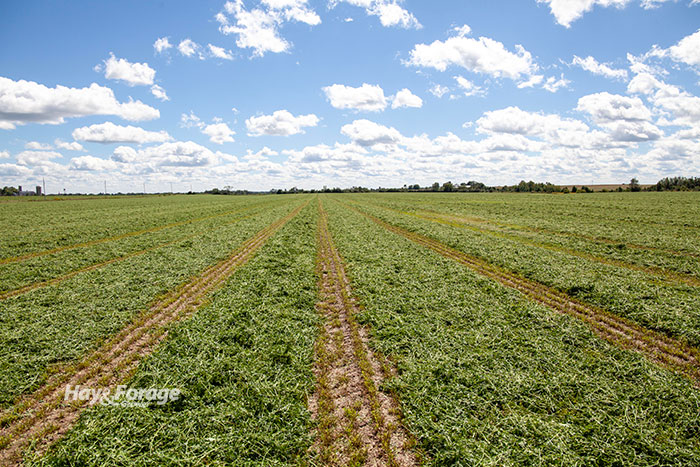
Even if the skies are clear and the radar doesn’t show any storm cells, it can still be challenging to ensure cut forage is dry enough to chop or bale. To make the drying processes more complex, the rate at which plants dry down fluctuates over time.
Forage is typically between 75% to 80% moisture immediately after harvest, but moisture levels must be about 60% to make haylage and between 14% to 18% to bale hay. Amanda Grev with the University of Maryland Extension says the faster moisture levels drop to these target ranges, the better.
“During the wilting and drying process, plants continue the natural process of respiration, breaking down stored sugars to create energy and carbon dioxide,” says the pasture and forage specialist. “Data suggests that 2% to 8% of the dry matter may be lost due to respiration, resulting in energy losses and an overall reduction in forage quality.”
Make wide swaths
Respiration continues to occur until forage moisture levels are below 60%. Until then, plants primarily lose moisture through their stomata, which are the openings on the leaf surface that facilitate water and gas exchange. Solar radiation is key to expedite this initial phase of the drying process and minimize dry matter and nutrient losses.
“This can be accomplished by using a wide swath — at least 70% of the cutting width — which will maximize the amount of forage exposed to sunlight,” Grev states. “A wider swath will increase the swath temperature, reduce the swath humidity, and keep the stomata open to allow for moisture loss.”
Another way to exploit solar radiation is to mow earlier in the day. Grev recommends waiting until the morning dew is dry and then aiming to cut forage in mid- to late morning.
Condition crops
Wide swathing is more important in the initial phase of drying than conditioning forage; however, conditioning does play a critical role in later stages of the process. Once respiration ceases and stomata close, moisture will be trapped inside plants and drying rates will slow. Conditioning provides an exit route for this moisture through the cracks that are created in plant stems.
“Be sure the conditioner is adjusted properly based on stem thickness and choose the best conditioner based on your forage type,” Grev states. “For example, roller conditioners are often preferred for alfalfa due to reduced leaf loss.”
Grev points out that stems can have low surface-to-volume ratios, fewer stomata, and a waxy cuticle that prevents water loss during the growing period. Conditioning helps rid plants of this tightly held water.
Other considerations regarding the forage drying process include cut height and raking. Adhering to an appropriate cut height will not only benefit forage regrowth and stand persistence, but Grev says sufficient plant stubble will elevate swaths and promote air flow for more rapid drying. Leave 2 to 3 inches of alfalfa stubble and at least 4 inches of stubble for cool-season grasses.
Rake hay before forage moisture levels fall below 40% to retain as many leaves as possible and maintain forage quality. Also, limit the number of rake tines that touch the ground to combat soil contamination.

Amber Friedrichsen served as the 2021 and 2022 Hay & Forage Grower summer editorial intern. She currently attends Iowa State University where she is majoring in agricultural communications and agronomy.

